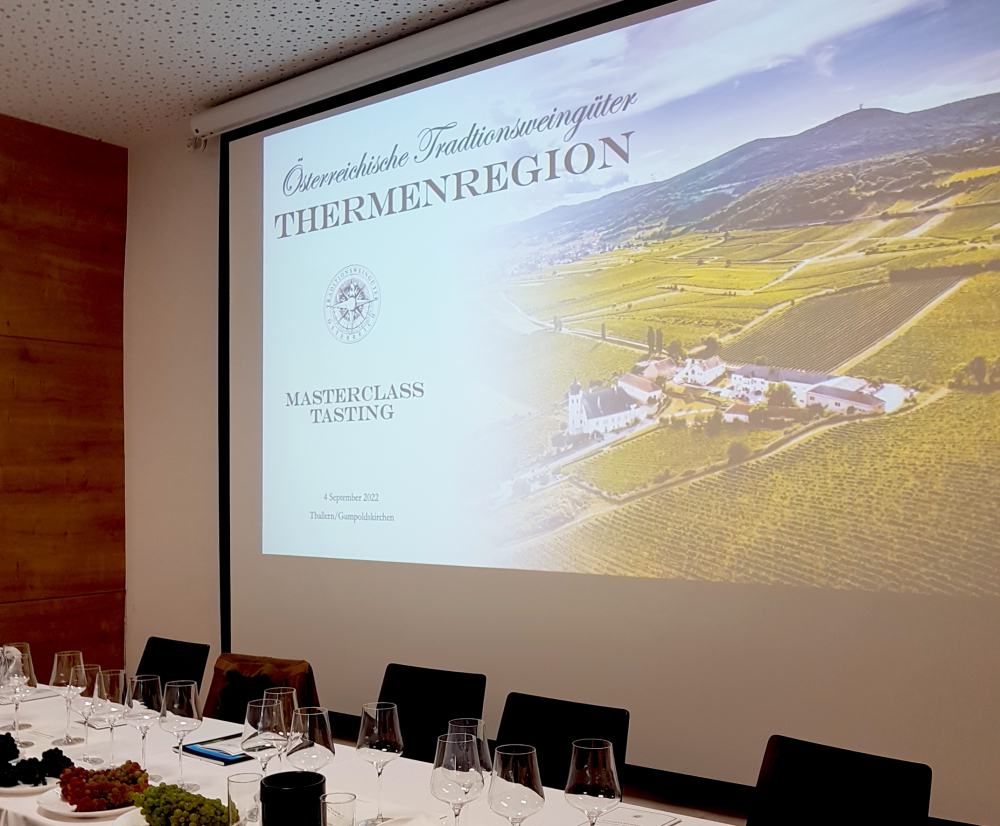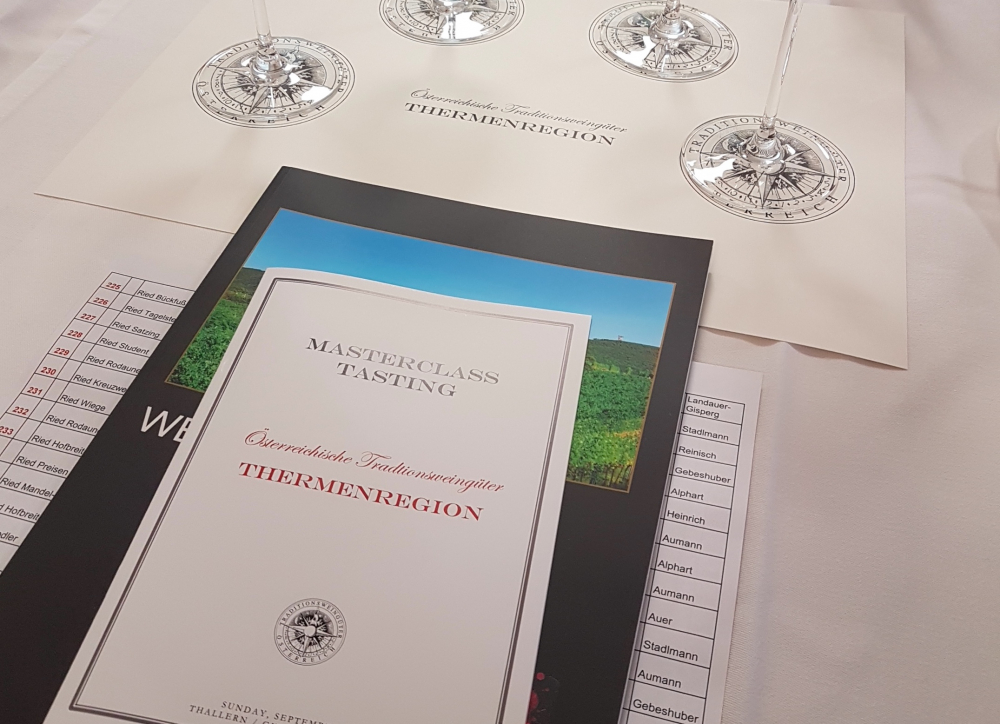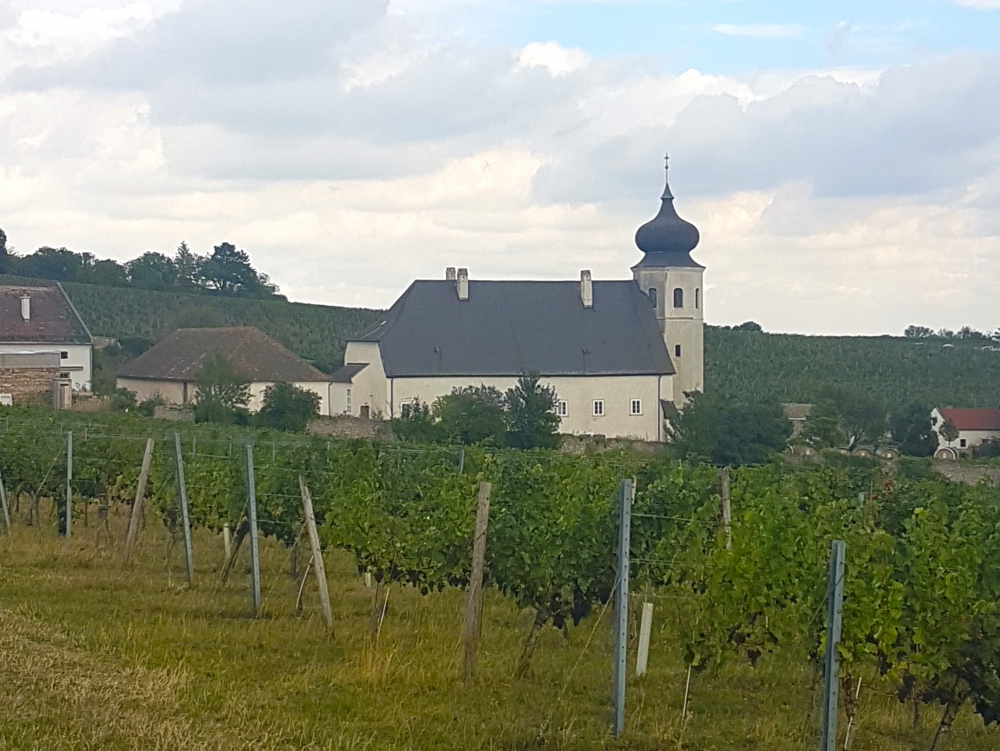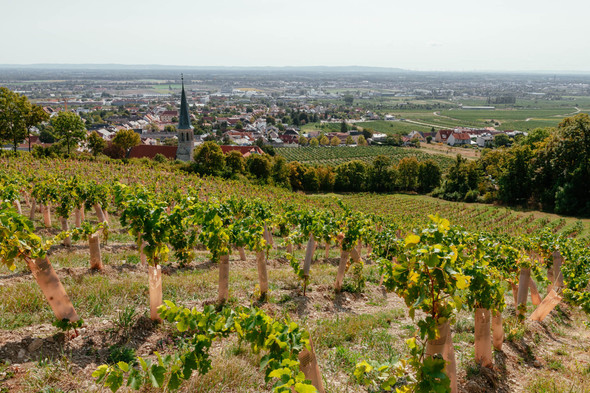The latest addition to the Erste Lagen single vineyard marathon was the Thermenregion, or ‘Thermal Springs Region’, with nine producers forming their local branch of the ÖTW earlier this year. Lying just south of Vienna, next to the Wienerwald, wines from this 2,300-hectare region used to be known as Wein von der Südbahn, or South Railway, as the railway line south to Italy ran through it, although Emperor Ferdinand loved the wines from here so much that a tunnel was built between Gumpoldskirchen and Traiskirchen to protect these precious vineyards. I have to say, I think the new name, referring to the hot, mineral-rich springs in the area, is somewhat more romantic, but I’m glad the emperor saved those vineyards!
Lying so close to Vienna, the Thermenregion is in easy reach of the thirsty dwellers of the capital, so many wineries opt to produce a large range of wines, so they have something to suit everyone’s tastes, including Austrian stalwart varieties Riesling, Grüner Veltliner (of course!), Pinot Blanc, Portugieser and Zweigelt. However, this means the region lacks the clarity of image that many other Austrian wine regions have created for themselves, where the region is closely associated with one or two grape varieties. Think Wachau, think Riesling or Grüner Veltliner. Think Styria, think Sauvignon Blanc or Morillon, as Chardonnay is often known there. Think Burgenland and Blaufränkisch is probably first to mind. Think Vienna and it’s Wiener Gemischter Satz. Yet, what do you think of when someone mentions the Thermenregion, unless you are true Austrian wine lover, then probably nothing leaps straight to mind.

Nevertheless, the Thermenregion, amidst its myriad of offerings, does have distinct varieties associated with it historically, which are lined up to be the protagonists in its forthcoming DAC. Zierfandler and Rotgipfler are the whites traditionally grown here, and hardly anywhere else, while Sankt Laurent and Pinot Noir have been deemed its best reds.
The perfect white match
Unless you are Austrian or a keen follower of Austrian wine, you’ve probably never heard of Rotgipfler or Zierfandler. So, what should you know?
Well Rotgipfler yields a rich, warm wine with tropical fruit and pear and hints of dark spice, which ages gracefully into a lovely melange of baked apple, honey and toast. It’s a natural crossing of Traminer and Roter Veltliner, which incidentally is no relation to its better-known namesake, Grüner Veltliner. While Zierfandler boasts higher acidity and a cooler expression overall with bright citrus and pineapple fruit developing into dried fruit and blossom as the wines age. You can also spot it in the vineyard, as Zierfandler’s berries turn pink on the side exposed to the sun, hence its other name, Spätrot. Incidentally, the variety is also grown in the Pécs wine region in Hungary, where it is known as Cirfandli and produces both dry and sweet wines.
In the past, the complementary pair were often blended (along with Neuburger) to create ‘Gumpoldskirchner’. Another style that was popular was ‘Spätrot-Rotgipfler’, which has been produced as ‘Königswein’ in Gumpoldskirchen since 1958 and has the honour of being the oldest registered trademark for an Austrian wine. They both boast great ageing potential as we saw at the single vineyard tasting; nevertheless, like so many of Europe’s other autochthonous varieties, they fell into obscurity. At least, only until now, we hope!
Pinot Noir and its offspring
Pinot Noir also has a long tradition in the region, having been cultivated here since its introduction by Cistercian monks in the 12th century. With a cool climate similar to that of the Loire, Burgundy and Champagne, the local vintners are now focussing on the variety, which thrives in the region. Fifteen different clones from Burgundy, Italy, Switzerland and Germany are used. Of course, it may also be known as Blauer Burgunder here, so don’t be confused by the name on the label. It produces lovely, elegant, cool-climate wines with red berry fruit, fine tannins, wild strawberry, citrus zest and floral notes as well as an occasional bitter almond character. The wines we tasted are certainly capable of giving German and Burgundian examples a run for their money!

Its offspring, Sankt Laurent, first documented in Austria in 1863 at Klosterneuburg, was first planted in the region in 1950. It is named after St Laurent’s Day, which falls on 10 August, when according to legend, its berries started to change colour. Although this may be much earlier now given climate change. However, St Laurent has a particularly valuable characteristic in this respect too, it rarely achieves alcohol levels of above 13-13.5% and retains beautiful freshness in this cool climate. Indeed, its future might shine bright in Austria in general, as the country boasts 800 hectares of the variety. The variety produces elegant wines with great finesse, fine-grained tannins and flavours of morello cherry and dark berries. Wines tasted back to 2008 were still holding their own. Like father, like son, it would seem!
Thermenregion in a nutshell
The region lies on the border of Lower Austria and Burgenland beyond the Leitha Range on the south and east-facing slopes of the Wienerwald (Vienna Woods), where white varieties thrive, and the warmer plain to the south, where black varieties are grown. Steiermark is to the west, Burgenland to the east and Vienna to the north. Cool alpine air meets the warmer Pannonian influence from the east, creating an almost marginal climate with good diurnal range, which is perfect for modern cool-climate viticulture, although wine has been made here for over 2,000 years. Roman legionnaires, like in so much of Central Europe, brought vines and knowledge which was later cultivated by the monastic orders in the Middle Ages. Monks from the Heiligenkreutz Monastery near Thallern, founded one of Austria’s oldest wineries – Weingut Thallern – second only to Nikolaihof in the Wachau.

Its most famed wine towns include Perchtoldsdorf, Gumpoldskirchen, Pfaffstätten, Baden, Guntramsdorf and Traiskirchen for white wine whites, and Bad Vöslau, Sooß and Tattendorf for reds.
Visiting the region
The region is easily accessible by rail or car from Vienna and is also just a stone’s throw away from the borders with Hungary and Slovenia. So, it’s easy to reach and explore, even on a day trip. So take a leisurely stroll among the vines and visit one of the charming Heurige (wine taverns) between Perchtoldsdorf and Wiener Neustadt. Watch out for the dangling fir branches or ribbons, meaning the tavern is open, so you can enjoy some seasonal fare and, of course, wine.
For full wine immersion, come when the Baden Wine Festival is in full flow or when the UNESCO listed Hiataeinzug is taking place in Perchtoldsdorf - a historical harvest thanksgiving festival to honour winegrowers, inscribed as Intangible Cultural Heritage.
As the region is located on a geological fault line, thermal water rises to the surface from deep underground, giving the wine region its name and making it home to the spa resorts of Baden and Bad Vöslau, so you shouldn’t miss taking a dip in the sulphuric waters at Römertherme Baden or Thermalbad Vöslau, perhaps after walking along the WeinWanderWeg in Gumpoldskirchen or boating on one of Europe’s largest underground lakes, in the Seegrotte Hinterbrühl.
If you fancy a bit of glamping, you could also sleep in a repurposed wine barrel at Schlaffass Tattendorf, just to immerse yourself totally in wine culture around the clock!






